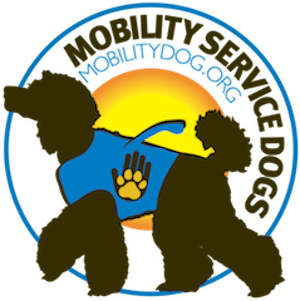Paws to Reflect on the Elegance of Your Dog's Feet
Mobility Service Dog, Beckett and Friends (Courtesy: MobilityDog.org)
Princess is a gorgeous dog, as you remind her all the time. Pretty eyes, soft fur, lovely smile. But how often do you think about her feet? Her feet are actually wonderful appendages, designed to do many things well. Moreover, we can tell a lot about what work Princess was bred to perform by examining the characteristics of her four paws.
Right front paw of dog: A) Claws, B) Digital Pads, C) Metacarpal Pad, D) Dew Claw and E) Carpal Pad. (Courtesy: Amos T Fairchild, Wikipedia)
Components of a Dog’s Foot
A canine’s paws comprise four main parts:
Claws, which your dog uses to get traction when running and to hold objects in place when eating or investigating.
Digital Pads, which lie adjacent to the claws and provide cushioning when walking and running, especially over rough ground.
Metacarpal Pad, a larger cushioning structure (of fatty tissues) providing additional shock absorption.
Carpal Pad, which lies further up the front legs and acts like a brake to control momentum on steep or slippery inclines.
Scientists believe that dogs were first domesticated in cold climates before spreading out into warmer zones with their human companions. Thick foot pads helped canines tolerate temperature extremes. Dogs that spend much of their time outside develop thicker, rougher pad skin – analogous to human callouses – whereas indoor dogs have smoother, softer pads.
Beyond these basic structures, however, are differences that tell a story about the type of work a breed was bred to do.
Cat Feet vs Hare Feet
Dogs bred for moving over rocky or uneven terrain tend to have compact feet, termed “cat feet.” The toes are of nearly identical length and form a half circle around the central foot pad. Think of cat feet as analogous to the knobby tires of an off-road vehicle, designed to improve grip over uneven surfaces. Dogs endowed with this foot structure can move fluidly in multiple directions over rough ground. Afghan Hounds are an example – they were developed to hunt agile prey over rocky surfaces.
In contrast, some dogs have a more elongated foot structure, termed “hare feet” with two elongated central toes. This elongated foot is an advantage for animals that primarily run straight ahead. Think of the slick tires on a drag race car, providing a sticky grip to aid in forward motion. Greyhounds, Whippets and Borzois have these delicate, compact feet built for speed.
What Do Dew Claws Do?
Some scientists consider the dew claws on the side of a dog’s foot to be vestiges of thumbs on both the front and rear legs. While the front dew claws contain both bone and muscle, the rear dew claws of dogs have little of either and are sometimes removed shortly after birth.
The function of dew claws may seem obscure, but they do have a purpose. Dogs have four tendons connecting the dew claw to the muscles of the leg, indicating that they can move individually. When a dog is galloping or jumping, the dew claws contact the ground. Moreover, when a dog turns sharply (as a dog herding sheep or cattle might do to keep the herd together), the dew claw digs in and helps with cornering. Dew claws also come in handy when a dog needs extra traction to move through snow, across the ice, or climb out of an icy pond.
Like so many traits of our furry friends, their feet are purpose-built to make them exceptional working companions. Consider rewarding your pup with a paw massage to promote relaxation and improve circulation. Also, give them the occasional (but carefully applied) pedicure to keep claws short enough so they don’t snag (don’t forget the dew claws!). A dog’s feet are its touch point with the world and need to be well-cared for to ensure Princess can move about with maximum aplomb and grace.


